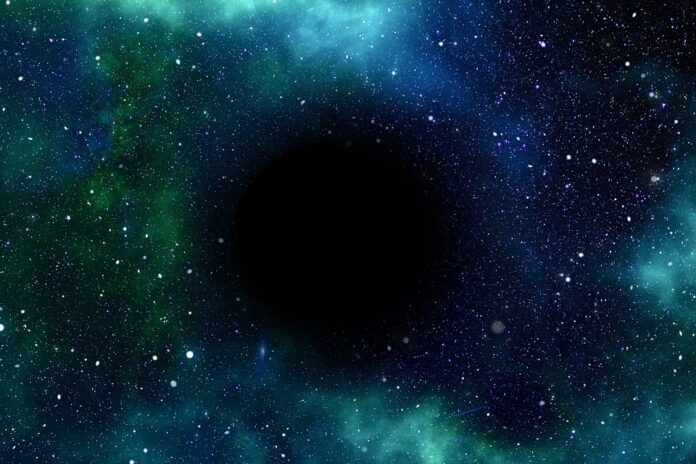An international scientific collaboration, led from Nagoya University (Japan), has investigated the nature of the dark matter that surrounds galaxies observed as they were 12,000 million years ago, that is, billions of years more ago than what has been achieved so far.
Their findings, published in the journal Physical Review Letters, open up the possibility that, going back so far and examining the early history of the universe, some fundamental rules of cosmology are not as believed. Observing and analyzing something that happened so long ago is difficult. Due to the finite speed of light, we see distant galaxies not as they are today, but as they were billions of years ago. But even more complex is observing dark matter, which does not emit light.
Dark matter
To investigate the dark matter of one galaxy, another, even more distant, source galaxy is often used. The gravitational pull of the foreground one, including its dark matter, distorts surrounding space and time, as predicted by Einstein’s theory of general relativity.
As light from the source galaxy travels through this distortion, it bends, changing the apparent shape of the galaxy. The greater the amount of dark matter, the greater the distortion. By analyzing this, scientists can measure the amount of dark matter surrounding the galaxy ‘lens’ what is in the foreground.
However, after a certain point a problem arises. The galaxies in the deepest parts of the universe are incredibly faint. Therefore, the further from Earth we look, the less effective this technique will be. Lens distortion is subtle and difficult to detect in most of these cases, so many background galaxies are needed to detect the signal.
Most previous studies have stalled there. Unable to detect enough distant source galaxies to measure the distortion, they could only analyze dark matter from no more than 8 to 10 billion years ago. These limitations left open the question of the distribution of dark matter between this time and 13.7 billion years ago, around the beginning of our universe.
The ‘echo’ or radiation residue of the Big Bang
To overcome these problems and observe dark matter from the far reaches of the universe, the team led by Hironao Miyatake of Nagoya University, in collaboration with the University of Tokyo, the National Astronomical Observatory of Japan and Princeton University (USA), has used a different source of backlight: the cosmic microwave background (CMB), the ‘echo’ of the Big Bang, the microwaves released shortly after the universe began.
First of all, with the help of the subaru telescope in Hawaii (specifically, data from the Subaru Hyper Suprime-Cam Survey), the authors identified 1.5 million lens galaxiesselected for viewing 12 billion years ago.
Next, to overcome the lack of light from even more distant galaxies, they used the WBC, that residue of radiation from the Big Bang recorded, in this case, by the Planck satellite of the European Space Agency (ESA). With the data or microwaves observed, it was possible to measure how the dark matter around the target galaxies distorted those microwaves.
“The main result is that it is the first measurement of the distribution of dark matter over galaxies from 12,000 million years ago”, confirms Miyatake to SINC. That is only 1.7 billion years after the beginning of the universe, which also means that these galaxies are being observed shortly after their formation.
“I am glad that we have opened a new window to that time, where things were very different -Add-. More galaxies are seen in the process of formation than at present. They also begin to form the first galaxy clusters”. These comprise between 100 and 1,000 galaxies held together by gravity with large amounts of dark matter.
Discrepancy with the cosmological model
Precisely one of the most interesting findings of the study is related to the agglomeration of dark matter. According to the standard theory of cosmology, the Lambda-CDM model, subtle fluctuations in the CMB form clumps of densely packed matter by attracting surrounding matter through gravity. This creates inhomogeneous clusters that form stars and galaxies in these dense regions. The new findings suggest that the agglomeration measurement is lower than predicted by the Lambda-CDM model.
Miyatake acknowledges that there are still some uncertainties in his result and more data will be needed to confirm it, “But if true, it would suggest that the entire model is flawed as you go back in time. This is exciting because it could suggest an improvement to the model and provide insight into the nature of dark matter itself.”.
The Japanese scientist is also aware that his result is quite new, so there is still not much discussion about alternative theories to explain it, “And honestly, theorists may not be interested in explaining it yet because of the uncertainties I was commenting on”.
“Nevertheless -underlines-, andwe started to see others evidences of Lambda-CDM breakdown (specifically, discrepancies in cosmological values called the Hubble parameter and sigma8), between the measurements of the late universe (8,000 million years ago to the present) and measurements of the ‘very’ early universe (about 400,000 years after the Big Bang)».
rmation on dark matter
“There are many candidates, such as the extension of the dark energy model and the modification of general relativities, but there is no theory that can explain these discrepancies perfectly. Our result falls somewhere between measuring the late universe and measuring the very early universe, and I hope it will help figure out which fundamental rules of cosmology can best explain our universe.”it states.
The next step is reduce uncertainties with more information. The group has only reviewed a third of the data from the Subaru Hyper Suprime-Cam Survey, and will now focus on the rest, which will offer an even more precise measurement of the distribution of dark matter.
In the future, the team hopes to use other data sources, such as the Legacy Survey of Space and Time (LSST) of the Vera C. Rubin Observatory, which is currently being built in northern Chile, to explore more areas of space and try to see the distribution of dark matter even further back in time, up to 13,000 million years ago.
Font: Enrique Sacristán / SINC Agency
Reference article: https://www.agenciasinc.es/Noticias/Miden-la-distribucion-de-la-materia-obscura-around-de-galaxias-from-12,000-million-years-ago











![[Img #74674]](https://thelatestnews.world/wp-content/uploads/2024/12/Santiago-Ramon-y-Cajal-The-promoter-of-modern-neuroscience-300x200.jpg)
Add Comment